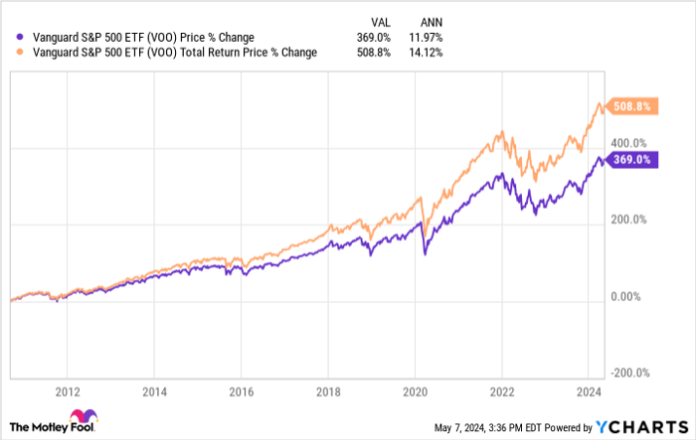There are a handful of must-follow fundamentals in stock investing, and the need for diversification sits high on the list. Diversification can help hedge against company or sector-specific risks and promote long-term portfolio stability.
Luckily, achieving diversification doesn’t have to involve buying dozens (or even hundreds) of individual stocks. It can be done with a few exchange-traded funds (ETFs) that cover a lot of ground.
Below are three ETFs that investors should consider adding to their portfolios in May. Each has a different focus that complements the others well.
1. Vanguard S&P 500 ETF
One ETF that I’ll almost always consider a screaming buy is the Vanguard S&P 500 ETF (NYSEMKT: VOO) because an investment in the S&P 500 is as close to an investment in the U.S. economy as you could ask for in the stock market.
The Vanguard S&P 500 ETF contains over 500 companies covering all 11 major sectors, giving exposure to the broader market. Here’s how it’s broken down by sector (as of March 31):
- Communication services: 8.9%
- Consumer discretionary: 10.3%
- Consumer staples: 6%
- Energy: 4%
- Financials: 13.1%
- Health care: 12.4%
- Industrials: 8.8%
- Information technology: 29.6%
- Materials: 2.4%
- Real estate: 2.3%
- Utilities: 2.2%
Since the ETF is market cap-weighted, the technology sector makes up a nice portion of it as large tech companies have exploded in value over the past few years. Even then, the ETF does a good job covering its bases and ensuring investors get exposure to top companies from all sectors.
After surging over 25% over the past 12 months, the Vanguard S&P 500 ETF is flirting with its all-time high, but that shouldn’t deter investors. It can be a foundational piece in most stock portfolios, so investors should focus more on making consistent investments over waiting for the “right” time to invest. That’s where dollar-cost averaging comes in handy.
History shows that dollar-cost averaging in an S&P 500 ETF is the right move, too. There will be ups and downs (as with any stock), but the Vanguard S&P 500 has been effective for investors since its inception.

VOO data by YCharts
2. Vanguard Growth ETF
The Vanguard Growth ETF (NYSEMKT: VUG) is similar to the Vanguard S&P 500 ETF because it includes only large-cap stocks, but what separates it is the focus on companies with high growth potential (hence the name).
For a while now, growth stocks have been a favorite of investors because of their market-beating potential. Typically, this growth potential comes with added risk because much of the valuations are based on potential. However, investors get more stability with large-cap growth stocks because these well-established companies generally have good financial backing.
The roughly 200-stock Vanguard Growth ETF is also heavily exposed to the tech sector. Eight of its top 10 holdings are tech companies, accounting for over 52% of the fund. Eli Lilly and Visa round out the top 10, bringing the total to just under 57%. The high concentration has been beneficial, with the ETF well outperforming the S&P 500 over the past decade.

VUG data by YCharts
The ETF’s high concentration stops it from serving as an investment one-stop shop, but it can be a great supplemental piece to a portfolio.
3. Vanguard High Dividend Yield ETF
The Vanguard High Dividend Yield ETF (NYSEMKT: VYM) is a good option for investors seeking passive income from dividends. It contains large-cap companies with above-average dividend yields, and its current yield is more than double that of the S&P 500.
The Vanguard High Dividend Yield ETF also contains companies from all 11 major sectors, but it’s much more diversified than the two above ETFs. The largest represented sector is financials, accounting for just over 20% of the ETF, followed by industrials (12.7%) and healthcare (12.4%).
Owning dividend-focused stocks is beneficial because they reward investors regardless of stock price performance. If a company or ETF’s stock price is doing well, consider it an added bonus. The Vanguard High Dividend Yield ETF stock growth has lagged a bit behind the S&P 500 over the past decade, but a healthy dividend has helped boost its total returns.

VYM data by YCharts
It’s also important to pay attention to an ETF’s expense ratio, especially if it’s dividend-focused. The Vanguard High Dividend Yield ETF is very low cost compared to comparable ETFs. Its expense ratio is 0.06%, or $0.60 per $1,000 invested. A low expense ratio ensures you can keep more of your returns to yourself instead of paying them out in fees.
Making money is great; keeping more of it for yourself is better.
Should you invest $1,000 in Vanguard S&P 500 ETF right now?
Before you buy stock in Vanguard S&P 500 ETF, consider this:
The Motley Fool Stock Advisor analyst team just identified what they believe are the 10 best stocks for investors to buy now… and Vanguard S&P 500 ETF wasn’t one of them. The 10 stocks that made the cut could produce monster returns in the coming years.
Consider when Nvidia made this list on April 15, 2005… if you invested $1,000 at the time of our recommendation, you’d have $550,688!*
Stock Advisor provides investors with an easy-to-follow blueprint for success, including guidance on building a portfolio, regular updates from analysts, and two new stock picks each month. The Stock Advisor service has more than quadrupled the return of S&P 500 since 2002*.
See the 10 stocks »
*Stock Advisor returns as of May 6, 2024
Stefon Walters has positions in Vanguard S&P 500 ETF. The Motley Fool has positions in and recommends Vanguard Index Funds-Vanguard Growth ETF, Vanguard S&P 500 ETF, Vanguard Whitehall Funds-Vanguard High Dividend Yield ETF, and Visa. The Motley Fool has a disclosure policy.
The views and opinions expressed herein are the views and opinions of the author and do not necessarily reflect those of Nasdaq, Inc.

